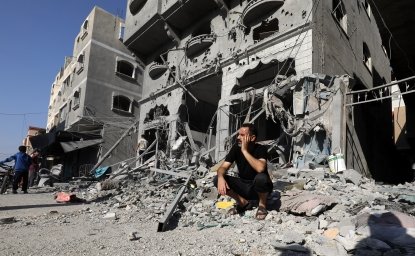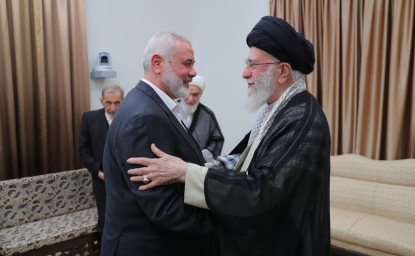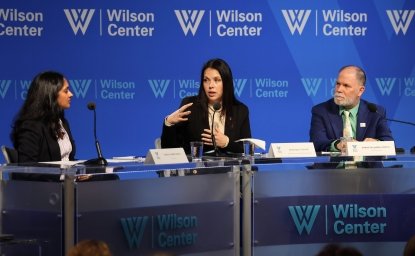The so-called Islamic State (ISIS) lost territory but persisted in pockets of territory in Iraq and Syria during the first half of 2018, according to a new report on Operation Inherent Resolve from the Department of Defense, the Department of State and the U.S. Agency for International Development. In contrast to the national trend in Iraq, “insurgent activity increased in Kirkuk, Diyala, and Salah ad Din provinces during the quarter.” Threats continued to emanate from the areas north of Baghdad as well. In Syria, ISIS held onto territory in the Middle Euphrates River Valley, and rural areas of southern Hasakah province, as well as a third pocket in the Yarmuk Basin in Dar’a province south of Damascus. The following are excerpts on developments in Iraq and Syria.
Iraq
ISIS ACTIVITY IN IRAQ DECLINED NATIONWIDE BUT PERSISTED IN SEVERAL PROVINCES
The DoD, the United Nations, and media sources reported a decline in violence in all but three provinces in Iraq. Civilian casualties during the first 5 months of 2018 fell 76 percent compared to the same period in 2017. Both the number of deadly vehicle-born IED attacks and IED casualties declined as well.
Lead IG analysis of open source information found that ISF deaths fell also, down to 126 killed in insurgent violence this quarter from 171 last quarter. The DoD reported that overall the pressure from ISF operations has kept ISIS on the move and denied the group the ability to coalesce to launch deliberate attacks.
The provinces of Anbar, Ninewa, and Baghdad experienced the biggest decline in insurgent incidents this quarter. In April, security forces protected more than 9 million people traveling through Baghdad during the Kadhimiya pilgrimage and prevented at least 2 attempted suicide bombings targeting pilgrims.
In Ninewa, security forces focused on increasing stability in Mosul and preventing ISIS infiltration from Syria. In early June, three divisions moved to western Ninewa to establish blocking positions and support Syrian Democratic Forces (SDF) operations across the border in Syria.
However, the DoD warned that ISIS networks in areas north of Baghdad city continued to pose a threat to the capital. In addition, in contrast to the national trend, insurgent activity increased in Kirkuk, Diyala, and Salah ad Din provinces during the quarter. Most of the violence occurred along the so-called “green line,” a swath of territory in northern Iraq claimed by both the central government and the Kurdistan Regional Government (KRG). In these areas, militants were able to move around and establish checkpoints at night with relative ease, exploiting the seam between at times competing security forces. Residents of some villages reportedly evacuated or abandoned their homes due to threats from remaining ISIS elements.
ISIS also carried out multiple kidnappings and abductions in Kirkuk, even as Coalition officials asserted that the province was getting safer. According to media reports, an increase in violence in northern Diyala prompted residents to stage a general strike to protest the absence of the Kurdish Peshmerga, which withdrew from the province following a failed Kurdish referendum on independence in May. Salah ad Din experienced the sharpest increase in violence, with incidents more than doubling this quarter compared to last quarter. In the 2 most violent of those incidents, militants killed 12 members of a single family and bombed the funeral of 3 Sunni tribal fighters, killing at least 10.
ISIS fighters sought to intimidate and punish groups or individuals who opposed them, or whom they suspected of collaborating with the ISF. In May, ISIS fighters in military clothes infiltrated a village north of Baghdad and killed 21 members of the Albu Faraj tribe. There were also multiple reports of ISIS fighters burning farmland and bombing a power transmission line to punish suspected ISF supporters or those who refused to pay protection money to the group.
Several incidents illustrated the extent to which ISIS attacks exacerbated sectarian tensions and raised human rights concerns. For example, at the end of June, ISIS fighters kidnapped six members of the PMF and released a video threatening to execute the hostages if the Iraqi government failed to release detained ISIS fighters, specifically Sunni women. The kidnapping prompted criticism of the government and created significant political pressure on Prime Minister Abadi, resulting in multiple police and military operations to recover the kidnapped personnel. On June 27, security forces recovered the mutilated bodies of the hostages. Shortly thereafter, Abadi called for the immediate execution of all convicted terrorists on death row, resulting in the execution of 12 convicts. The incident not only underscored tensions between the Sunni and Shia populations, it also caused human rights groups to raise concerns about the speed of trials for terrorist suspects in Iraq, unlawful detentions, and the lack of evidentiary standards and due process for the accused. For an overview of casualties caused by insurgents, by province in Iraq this quarter, see Figure 1.
ISIS also sought to target Iraq’s election infrastructure and attempted to disrupt parliamentary elections held this quarter. While relatively minor compared to previous quarters, ISIS attacks included a car bomb targeting a candidate for the Turkmen Front in Kirkuk province that killed 1 civilian and injured 11 other people, a shooting at the convoy of another member of Parliament, an improvised explosive device (IED) attack that injured the Secretary General of the Free National Current Party in Kirkuk, and a double suicide bombing at the headquarters of the al-Hal Party, which killed 3 security personnel and wounded 7 others including a parliamentary candidate. The ISIS-affiliated Amaq News Agency released a video showing ISIS militants executing two “election advocators,” likely in an effort to prevent voters from participating in the vote.31 In May, shortly after the election, ISIS claimed a suicide bombing at a public park in Baghdad that killed 15 people and wounded another 19.
Syria
ISIS TERRITORY SHRANK BUT THE ORGANIZATION REMAINED A THREAT
Speaking at a meeting of the Coalition political directors on June 26, U.S. Special Presidential Envoy McGurk said that ISIS continued to hold about 2 percent of the territory once under its control in Iraq and Syria. Its remaining territory was concentrated in two pockets in eastern Syria, the Middle Euphrates River Valley, and rural areas of southern Hasakah province, as well as a third pocket in the Yarmuk Basin in Dar’a province south of Damascus. U.S. officials said ISIS militants still maintained widespread clandestine networks and were primarily fighting in small groups of three to five people. These ISIS cells, often moving through tunnels, carried out several lethal attacks in multiple provinces, including high-profile attacks against Syrian regime and pro-regime forces and attacks against the SDF.
In Raqqah province, for instance, ISIS claimed an IED attack on a checkpoint that killed an SDF fighter, and a bombing that killed five SDF fighters on patrol. In June, ISIS detonated several IEDs in Idlib, killing commanders of the opposition Free Syrian Army and Islamist Hayat Tahrir al Sham. For an overview of territory under ISIS’s control in Syria this quarter, see Figure 6.
In Dayr az Zawr province, ISIS used at least 10 suicide bombers to kill regime soldiers in Abu Kamal. ISIS also struck Russian artillery positions in Dayr az Zawr, killing four Russian soldiers. In the south, ISIS launched a series of attacks on regime forces from positions in the Syrian desert, but lost control of the Yarmouk refugee camp south of Damascus.
The DoD reported that ISIS has not yet identified itself as an insurgency but rather continued to see itself as a state with a standing army. The DoD reported that ISIS was conserving its forces for an insurgency that the DoD predicted would stretch across the desert in eastern Syria and western Iraq, terrain that is well suited as a base for guerilla warfare. The DoD predicted that ISIS would rely on a rural and desert insurgency in addition to urban warfare to recruit members and “lay the groundwork for a comeback.” The desert terrain would allow them to regroup, run sleeper cells, rebuild finances through extortion, and plot attacks.
The DoD reported that ISIS significantly reduced its financial operations in Syria this quarter. ISIS generated revenue from limited oil activities, extortion and taxation, and other illicit trafficking activities, but suffered shrinking cash reserves. On June 19, an airstrike killed a senior ISIS operative in charge of managing revenue generation from illicit oil and gas sales, which the DoD said would further hamper ISIS illicit finance efforts.
Click here for the full report.

The Islamists
Learn more about Hamas and how it relates to similarly aligned organizations throughout the region. Read more

Explore More
Browse Insights & Analysis
Israel Escalates Attacks in Gaza: What’s Next?

Israel Expands Operations on Multiple Fronts: Perspectives on the Conflict

